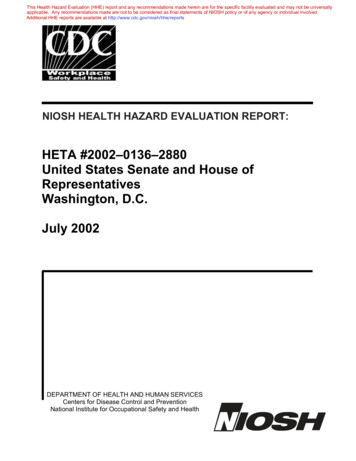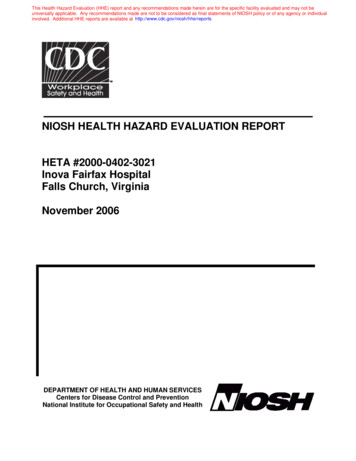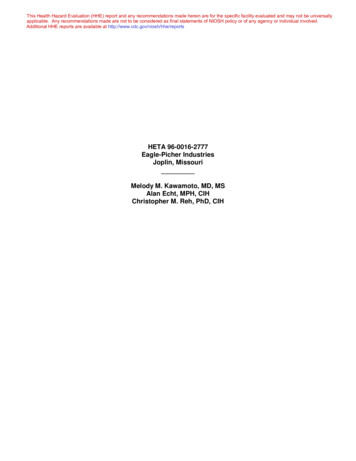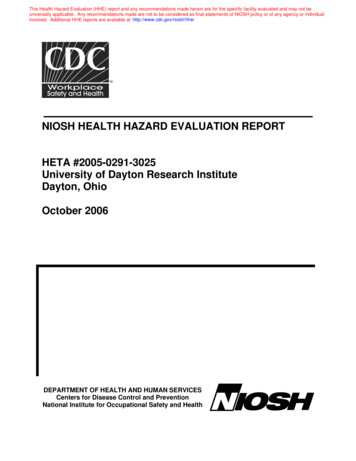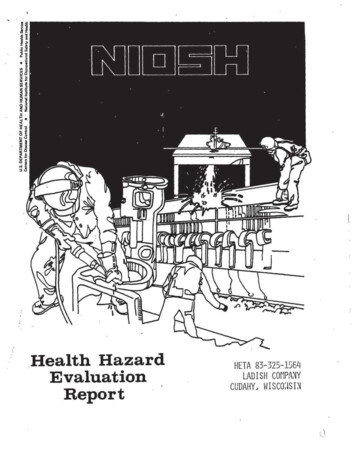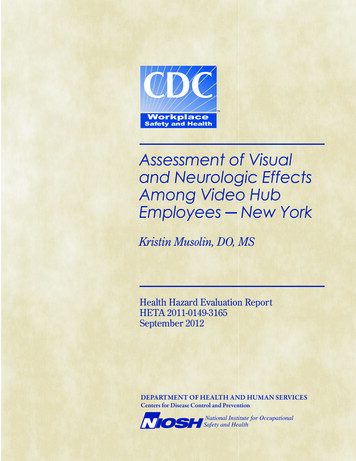
Transcription
WorkplaceSafety and HealthAssessment of Visualand Neurologic EffectsAmong Video HubEmployees New YorkKristin Musolin, DO, MSHealth Hazard Evaluation ReportHETA 2011-0149-3165September 2012DEPARTMENT OF HEALTH AND HUMAN SERVICESCenters for Disease Control and PreventionNational Institute for OccupationalSafety and Health
The employer shall post a copy of this reportfor a period of 30 calendar days at or nearthe workplace(s) of affected employees. Theemployer shall take steps to insure that theposted determinations are not altered, defaced,or covered by other material during suchperiod. [37 FR 23640, November 7, 1972, asamended at 45 FR 2653, January 14, 1980].
ContentsReportAbbreviations.iiHighlights of the NIOSH Health Hazard ussion.8Conclusions. 10Recommendations. 10References. 13AcknowledgmentsAcknowledgments and Availability of Report. 15Health Hazard Evaluation Report 2011-0149-3165Page i
HOPage ii1080 interlacedThree-dimensionalHealth hazard evaluationLiquid crystal displayLight emitting diodeNorth American Industry Classification SystemNational Institute for Occupational Safety and HealthOccupational Safety and Health AdministrationPersonal protective equipmentTelevisionVideo hub officeHealth Hazard Evaluation Report 2011-0149-3165
Highlights of theNIOSH HealthHazard EvaluationWhat NIOSH Did We visited the facility on February 2–3, 2012. We evaluated employees’ visual and neurologic symptomsand workplace conditions. We measured viewing distances from desktop workstations towall monitors. We talked with employees about their work and health concerns.The National Institutefor Occupational Safetyand Health receiveda request for a healthhazard evaluation at avideo hub office in NewYork. The union submittedthe request because ofconcerns about visual andneurological symptomsamong employees whomonitored televisiondisplays. We reviewed employee medical records and logs of workrelated injuries and illnesses.What NIOSH Found The video hub office was well maintained. Most employees reported multiple symptoms when at work.The most commonly reported symptoms were eyestrain,headache, and body aches. The distance from the first row of desktop monitorworkstations to the wall monitors was approximately 84inches. The average distance from the user to the desktopmonitor was 37 inches. As a result, looking back and forthbetween nearby and far objects that are different distancesmay cause eyestrain. The desktop monitors varied in brightness and contrastsettings. Some monitors were not at the same level or angle. The chairs in the video hub were adjustable, but did nothave headrests. Video hub office technicians worked 10-hour shifts with 4days on and 3 days off. Every 2 months technicians rotatedbetween 5 different shifts covering 24 hours. Shift workmay increase health and safety risks by disturbing sleep andcircadian rhythms. Most employees thought management did an adequatejob of letting them know what was being done to addressworkplace concerns.What Managers Can Do Provide employees with adjustable ergonomic chairs. Thesewill help increase employee comfort and improve their abilityto view multiple monitors.Health Hazard Evaluation Report 2011-0149-3165Page iii
Highlights of theNIOSH HealthHazard Evaluation(continued) Use computer monitors that are height adjustable and havenon-glare screens. Regular cleaning should improve visibilityand reduce eyestrain. Encourage employees to use proper posture when viewingmonitors. Also, encourage employees to take breaks to stretchand rest their eyes. Encourage employees to report any health concerns that maybe related to their work to their health care provider. Promptly address any concerns that employees report. Theemployees should be notified about what is being done toaddress the concern and what future actions are planned. Evaluate work shift scheduling. Keep consecutive night shiftsto a minimum, and consider forward rotating shifts.What Employees Can Do Report all health and safety concerns to your manager. Seek care from an occupational health physician if you havesymptoms or concerns related to your work. If you are havingproblems with your eyes you should see an optometrist orophthalmologist. Wear the appropriate personal protective equipment. Laserglasses, 3-D glasses, and earmuffs may protect you while at work.Page ivHealth Hazard Evaluation Report 2011-0149-3165
SummaryNIOSH evaluatedconcerns that excessivevisual stimuli in their workenvironment contributedto employees’ visual andneurological symptoms.Most employees reportedone or more healthsymptoms that may havebeen related to theirjob duties. NIOSH madeergonomic and proceduralrecommendations todecrease symptomsand improve employeecomfort.In September 2011, NIOSH received a union request for anHHE concerning visual and neurological symptoms amongemployees at a VHO in New York. Employees thoughttheir symptoms may have been associated with long-termmonitoring of multiple standard and high definition fiberoptic fed TV displays for audio and video imperfections.NIOSH conducted a site visit on February 2–3, 2012.We interviewed employees in a private setting to discusstheir health and workplace concerns and reviewed medicalrecords. The distances between video monitors and employeeworkstations were measured. During our interviews, 10of 12 employees reported one or more health symptoms;most reported eyestrain, headache, pain or body aches, anddrowsiness. A history of migraine headaches that occur morefrequently at work was reported by 3 of 12 employees. Wefound the distance from the first row of desktop monitorworkstations to the wall monitors was approximately 84inches. The average distance from the user to the desktopmonitor was 37 inches. As a result, looking back and forthbetween nearby and far objects that are different distancesmay cause eyestrain. We provided recommendations tomanagers and employees to help lessen eye strain andergonomic complaints while at work.Keywords: NAICS 517210 (Wireless Telecommunications Carriers[except Satellite]), neurologic symptoms, television monitors,computer, telecommunication, LED, vision symptoms, video hubofficeHealth Hazard Evaluation Report 2011-0149-3165Page v
This page left intentionally blank.Page viHealth Hazard Evaluation Report 2011-0149-3165
IntroductionIn September 2011, NIOSH received a request for an HHE at atelecommunications VHO in New York. The CommunicationWorkers of America local union submitted the request on behalfof VHO employees who were concerned about health effects thatincluded headache, nausea, and visual impairments (blurred vision,double vision, and eyestrain). Some employees felt these symptomswere a result of continuous visual monitoring of multiple standardand high definition fiber-optic fed TV and computer displays,including a 3-D monitor. Prior to the site visit, we requested andreceived a roster of current employees and OSHA Form 300 Injuryand Illness Logs from 2005–2010. Managers also provided picturesof the VHO and a description of video hub technician generalduties, qualifications, and training.During the site visit on February 2–3, 2012, we met with union,management, and employee representatives to discuss the NIOSHHHE Program and the request. We toured the video hub area,telecommunications equipment room, equipment buildingroom, equipment workshop room, antenna room, and generatorroom. During the tour, we observed work processes, practices,and workplace conditions, and spoke briefly with employees inthe video hub area. We also interviewed a sample of employeesduring the site visit and by phone. Managers, engineers, and videohub technicians from morning, day, and night shifts participatedin these voluntary, confidential interviews. We also measuredworkplace viewing distances to determine if the distances compliedwith the standards for ergonomic workplace design.BackgroundThe building that housed the VHO was constructed in 1929;however, the VHO itself was constructed in June 2008 on thebuilding’s second floor. The company operated 12 VHOs plus othersmaller remote sites nationwide. VHOs take channel signals for theirregion and prepare them for distribution to customers. Employeesinclude managers, engineers, and VHO technicians; the techniciansare represented by the Communication Workers of America.Process DescriptionThe telecommunication facility was a 24-hour operation whereemployees monitored displays for signal degradation as well asaudio and video imperfections to maintain acceptable picture andHealth Hazard Evaluation Report 2011-0149-3165Page 1
Introduction(continued)sound quality. Channels were monitored in standard and highdefinition. Specifically, VHO technicians analyzed and distributedcontent through a fiber-optic network for three local and nationalareas. Technicians also monitored the emergency alert system andplaced advertisement content locally and nationally. Advertiserssent their commercials to the VHO, and the technician insertedthem into programming as required.Work schedules for VHO technicians included five shifts:1. 12 p.m. to 10 a.m.2. 6 a.m. to 4 p.m.3. 10 a.m. to 8 p.m.4. 4 p.m. to 2 a.m.5. 8 p.m. to 6 a.m.VHO technicians rotated every 2 months with 4 days on and 3 daysoff for 10-hour shifts. For example, five employees worked for thefirst half of the week, and another five employees worked the lasthalf of the week. However, some did not rotate because of seniorityor medical reasons. Engineers rotated every 3 months between dayand night shifts and could take calls from home. Managers worked5 days a week and were on call 24 hours a day, 7 days a week.Video hub technicians had a mandated 30-minute lunch and two15-minute breaks per shift. Inside the VHO were a total of 56 fiberoptic fed video monitors and computer desktop flat panel monitors(Figures 1 and 2) as follows: Nine workstations, with three rows containing threeworkstations each. Each workstation had four 20-inch computerdesktop flat panel monitors, for a total of 36 monitors. A 42-inch 1080i LCD used to monitor an unmanned localVHO for security reasons A series of set top cable boxes with three 42-inch LED 1080imonitors used for troubleshooting on both sides of the VHOarea desktop environment (six total) A 50-inch 3-D monitor that was used for programming on alimited basis Six 42-inch (two brands) LCD 1080i monitors with fixed tiltabout 30 degrees downward from the wall Six Barco branded (highest resolution) displays with“thumbnail widgets” (split screens) parallel to the wallPage 2Health Hazard Evaluation Report 2011-0149-3165
Introduction(continued)Figure 1. On the wall are fiber-optic fed video monitors in the VHO–Barco branded and 42-inch LCD displays.Figure 2. Employee surveying the fiber-optic fed video wall monitors(channel scan) and “thumbnail widgets” (split screens) on Barcobranded screens in the VHO.VHO employees typically sat in the first row of workstations closestto the wall monitors in the VHO area. This set-up facilitated accessto the set top cable boxes for calibrating the remote control to thedisplay monitor.VHO employees were responsible for identifying audio and videoimpairments inside and outside the VHO. They maintainedprimary and secondary channels, video on demand, national andHealth Hazard Evaluation Report 2011-0149-3165Page 3
Introduction(continued)local content reception and processing, advertisement inserts, andmedia guide content inserts. Employees reported that some oftheir duties included the following: Performing routine checks every 3 hours Verifying fiber-optic blackout lists on a website andprinting a paper copy Visually scanning standard and high definition channelsfor approximately 30–45 minutes or up to 1½ hours ifonly one employee on duty per shift Checking thumbnail widgets on Barco branded screens Checking the power generator in case of a power outage Auditing and scanning parts (occasionally) Checking the emergency alert system and video ondemand by purchasing a video and checking the mainfunctions Checking the telecommunications equipment room Surveilling video broadcast network and equipment Inspecting VHO equipment and maintenance on computerdesktops Performing fiber-optic wire operations occasionally on nightshift during a maintenance window event (12 a.m. to 3 a.m.) Continuous monitoring for alarms or failed network pathsThe telecommunications equipment room was divided intonetworks for three locations. Each network included numerousencoders for video multiplex streaming, optical fiber routers,servers for monitoring VHO desktop flat panel computers,wireless routers for remote access, power supplies, service andmedia guide computers, encryption modulators, satellite receiverservices, and emergency alert system computers.The equipment building room was used by contractors to buildequipment that was transferred to the care of the telecommunicationnetwork facility for maintenance. The equipment workshop roomwas used to store spare parts, cables, and tools. The antenna roomprovided antenna grounding for protection from lightning strikes.The power generator room was downstairs from the VHO floor andhad a 750 kilowatt backup generator.Page 4Health Hazard Evaluation Report 2011-0149-3165
ResultsOSHA Form 300 Logs of Work-RelatedInjuries and IllnessesThe OSHA Logs for years 2005–2010 included four injuries. Oneof the injuries entailed lower back strain as a result of overexertionin a VHO employee. The remaining injuries were in fieldtechnicians and a central office worker.Employee InterviewsWe interviewed in person or by phone 12 of 15 employees whowere present on the day of the site visit. Three employees declinedinterviews. Employees were asked to discuss their work responsibilitiesand practices, PPE use, and any work-related health concerns.PPE used in the VHO varied among the employees. A fewemployees chose to wear earmuffs (provided by the company)in the VHO because of the distraction and noise from multipleaudio signals. Most employees reported wearing earmuffs in thetelecommunications equipment room only if they anticipateda longer stay when repairing or investigating a problem. Aprevious OSHA site visit found noise levels in this room were82–85 decibels and did not exceed the permissible exposurelimit. Two employees reported not wearing laser glasses becausethey never evaluated fiber-optic cables. All employees reportedwearing 3-D glasses when they checked 3-D programming. Whenasked about regular comprehensive eye exams, seven employeesreported receiving exams within the last year from their personaloptometrist; one of these employees was previously diagnosedwith phlebitis and dry eye, and one was diagnosed with vestibularmigraines associated with photophobia. Four employees reportedreceiving eye exams every 2 years; one noted needing a strongereyeglass prescription. One employee reported his last eye exam was3 years ago.Participation and DemographicsThe VHO had 15 employees, including 5 managers. Demographicsof the 12 interviewees were as follows: 12 (100%) males, averageage of 49 (range 31–65). The average length of employment withthe company was 10 years (range 2–29 years; median 4 years). Forthe seven VHO technicians interviewed, the average length ofHealth Hazard Evaluation Report 2011-0149-3165Page 5
Results(continued)employment was 3 years (range 2–6 years; median 4 years). SevenVHO employees reported that they had previously worked atanother VHO.Employee SymptomsOf the 12 employees interviewed, 10 reported having healthproblems that began and occurred only at work; some also notedprogression of symptoms over time. Work-related symptoms arelisted in Table 1. Eyestrain was the most common work-relatedsymptom; it was reported by 8 of 12 (67%) employees. When askedwhat they thought caused their symptoms, employees gave variousresponses, including inactivity, repetition, history of eye and/ormigraine headache symptoms, shift work, constantly slouching,and viewing several broadcasts simultaneously. Specific questionsrelated to neurologic conditions were also asked; results are listedin Table 2.Table 1. Work-related symptoms reported by employees (N 12)SymptomsNEyestrainHeadachePain or body achesDrowsinessTinnitusEye fatigueBody fatigueDizzinessUnsteadinessBlurred visionDisorientationNausea877644433221Table 2. History of specific neurological conditions reported byemployees (N 12)Page 6Health ConditionNMigrainesMotion sicknessNystagmus (involuntary eye movement)321Health Hazard Evaluation Report 2011-0149-3165
Results(continued)Medical Record ReviewWe reviewed medical records for one VHO employee. Thisemployee underwent several tests conducted by a variety of medicalspecialists to evaluate their dizziness, migraines, unsteadiness,vertigo, muscle aches, and tinnitus (ear ringing). The employee’smedical record indicated that the symptoms may or may not havebeen related to work, and the cause of vertigo was unknown.A neuro-ophthalmologic consultation failed to determine theprecise nature of the visual changes. The employee’s physicianrecommended refraining from watching television in social andoccupational settings.Health and Safety ConcernsA common employee concern was the practice of having oneemployee on duty at a time, especially during nights and weekends.This required employees to perform routine 3-hour checksconsecutively, and the concern was that this schedule contributedto their symptoms. Most interviewed employees believed that theemployer appropriately communicated the steps taken to evaluateand resolve potential health hazards and issues in the workplace.Work PracticesWhen asked how much time they spend continuously watching themonitors without a break, most employees reported 30 minutes to 1½hours during a channel scan that was performed daily every 3 hours.Managers stated that in addition to the scheduled breaksemployees were free to move around the facility. VHO techniciansreported that when there was only single coverage (usually duringnights or weekends) they usually worked together with the VHOengineers to coordinate breaks.We measured the distance from the first row of desktop monitorworkstations (the row most of the VHO employees operate in)to the wall monitors. The approximate distance was 84 inches.The typical distance from the user to the desktop monitor was 37inches. Managers mentioned that the VHO employees’ operationworkstation location was mostly based on what the employees feltmost comfortable with, which determined the distance.Health Hazard Evaluation Report 2011-0149-3165Page 7
DiscussionVHO employees were required to constantly view several monitorsat the same time. This may lead to occupational asthenopia(eyestrain) and other symptoms that are grouped together underthe term computer vision syndrome [Anshel 2007]. Computervision syndrome is a complex of eye and vision problems related tonear-computer use [AOA 2011]. Wall-mounted LCD displays andcomputer monitors on desktop workstations at the VHO facilityprovided opportunity to develop eyestrain and other visual symptoms.The terms eyestrain and eye fatigue are typically usedinterchangeably and are characterized by internal and externalsymptoms. Internal symptoms include pain and headache. Eyedryness and irritation are external symptoms and are usuallyexperienced when reading in the presence of glare, flickering light,and small font size [Anshel 2007]. According to Gowrisankaran etal., decreased blink rate (eye dryness) and eyestrain are associatedwith computer work, cognitive load, and visual stress of a task[Gowirsankaran et al. 2012]. Computer-related dry eye may becaused by decreased blink rate, high gaze angle, or dry officeenvironment [Anshel 2007].Headaches, blurred vision, and diplopia (double vision) occurwhen the eyes try to compensate for a deficiency in focusing abilityand uncorrected pre-existing vision conditions [AOA 2011]. Visualsymptoms result from visual stress on the cross-linkages betweenthe processes of accommodation (focusing) and vergence (fixatingon near and far objects that require visual tracking of movingobjects) [Barrett 2003]. The resting point of vergence changes withviewing angle. For those who exhibit a change in their resting pointof vergence when looking up and down, a downward gaze anglesignificantly reduces headaches and eyestrain and, to a lesser extent,blur and mental fatigue [Tyrrell and Leibowitz 1990]. Focusing ontargets that differ from the eye’s resting points requires help fromextraocular and intraocular muscles [Sommerich et al. 2001].Factors contributing to eyestrain include individual visioncharacteristics, personal work habits, and workplace conditions.Other factors such as improper viewing angle/focal distance,inappropriate lighting/glare, and screen characteristics such ascontrast, flicker, and jitter may lead to eyestrain [Clark 1996].Workers over 40 years of age are predisposed to eyestrain(headache, eye fatigue, and irritation) because they typically requirehigher illumination levels than younger workers to performthe same job [NIOSH 1998]. The World Health OrganizationPage 8Health Hazard Evaluation Report 2011-0149-3165
Discussion(continued)recommends an eye examination prior to employment andthen periodic examinations beyond age 40 years, especially forindividuals who report musculoskeletal or eyestrain symptoms[WHO 1990]. The American Optometric Association recommendsan eye examination for employees working in occupations thatare “highly demanding visually or eye hazardous” every 1 to 2years for those 18–60 years of age on the basis of an optometrist’sprofessional judgment. Employees age 61 and older should haveexaminations at least annually or more frequently on the basis oftheir personal medical history [AOA 2005].Eyestrain and other related neurologic symptoms such asdisorientation, dizziness, unsteadiness, and nausea may be aresult of motion sickness or viewing objects moving in a virtualenvironment setting (including 3-D properties). Visual vertigo isdefined as visual environments with large or repetitive movingvisual patterns [Bronstein 2004]. The trigger for visual vertigo isvisual; however, the symptoms are vestibular in nature. The goalof treatment is to increase tolerance to visual stimuli [Bronstein2004]. Most employees, however, reported that vision problemsexperienced while at work ceased once they were at home.Individuals with visual vertigo may experience prolonged visionproblems when not at work, and symptoms may worsen if notaddressed [AOA 2011].Eye movement occurs with repetitive and static postures duringcomputer use. Repetitive posture is repeating a movement foran extended period of time, and static posture is maintaining aposture for an extended period of time [Anshel 2007]. Not onlydo computer use and video monitor displays create awkward eyepostures, but they also create awkward musculoskeletal postures.In the study by Grandjean et al. most operators preferred to leanbackward in their chairs even if the chairs were not suitable for thatposture [Grandjean et al. 1983]. The VHO employees reported asimilar preference for leaning back in chairs.Sommerich et al. concluded that computer monitor viewing anglesignificantly affected muscle activity, posture, and performance.The approximate distance from the user and the computer monitorat the VHO was 37 inches. Sommerich et al. found an averagepreferred distance ranging from 29.5 to 32.7 inches and notedthat employees did not vary the distance when viewing angles ofthe monitors changed. Sommerich et al. recommend a practicaldistance of 18–30 inches to decrease work-related musculoskeletalHealth Hazard Evaluation Report 2011-0149-3165Page 9
Discussion(continued)symptoms and help maintain an upright posture [Sommerich et al.2001]. The recommended visual display distance is between 19.6and 39.4 inches [ANSI/HFES 2007].Because VHO services were provided 24 hours a day, mostemployees usually rotated shifts. Shift work, especially working atnight, can lead to sleep and circadian rhythm disturbances anddecreased work performance. Even employees who consistentlywork at night never fully adjust [Rosa and Colligan 1997].Rotating workers forward from evening to night shifts rather thanbackwards from night to evening shifts makes it easier for circadianrhythms to adjust [Knauth and Hornberger 2003].ConclusionsRecommendationsThe VHO telecommunication work environment, which requiredextensive visual tracking during 10-hour work periods, mayhave resulted in employees reporting adverse health effects. Therecommendations listed below may improve visual accommodationand spatial orientation over long periods of time and should helpprevent the visual and neurologic symptoms the employees at theVHO reported.On the basis of our findings, we recommend the actions listedbelow to create a more healthful workplace. We encouragethe telecommunication company to use a labor-managementhealth and safety committee or working group to discuss therecommendations in this report and develop an action plan. Thoseinvolved in the work can best set priorities and assess the feasibilityof our recommendations for the specific situation. In most cases,the preferred approach is to eliminate hazardous materials orprocesses and install engineering controls to reduce exposure orshield employees. Until such controls are in place, or if they arenot effective or feasible, administrative measures and/or personalprotective equipment may be needed.Engineering ControlsEngineering controls reduce exposures to employees by removingthe hazard from the process or placing a barrier between thehazard and the employee. Engineering controls are very effectiveat protecting employees without placing primary responsibility ofimplementation on the employee.Page 10Health Hazard Evaluation Report 2011-0149-3165
Recommendations(continued)1. Provide ergonomic chairs with headrests, adjustable heightcontrols, lumbar support, and 360-degree swivel capabilityso it is easier to view and access multiple monitors withouttwisting. Padding on the seat, back, and armrests helpsminimize pressure points and improves comfort.2. Provide non-glare screens and height adjustable computermonitors for employees. Adjust the brightness so it isapproximately the same as the surroundings; adjust contrastas high as possible to eliminate discomfort. Clean screensregularly to remove dust that may decrease visibility.Administrative ControlsAdministrative controls are management-dictated work practices andpolicies to reduce or prevent exposures to workplace hazards. Theeffectiveness of administrative changes in work practices for controllingworkplace hazards is dependent on management commitment andemployee acceptance. Regular monitoring and reinforcement arenecessary to ensure that control policies and procedures are notcircumvented in the name of convenience or production.1. Encourage VHO employees to position their body withcorrect upright posture when facing a monitor rather thanonly moving their neck. Adjust the angled monitors so thatthey are at a level to reduce neck strain.2. Require employees to receive a comprehensive eye examprior to starting work and at a frequency recommended bytheir optometrist or ophthalmologist. They should discussthe nature of their work with their optometrist. Employeeswho experience eyestrain and associated symptoms(headache; eyestrain; blurry vision; dry eyes; irritated eyes;eye fatigue; neck, back, and shoulder pain; and doublevision) should seek medical attention from an appropriatehealthcare provider. Employees who wear glasses or contactlenses and experience eyestrain should see an optometristto ensure they are wearing the correct eye prescription forcomputer and distant viewing work.3. Encourage employees to take more breaks to allow for restand recovery. Taking short breaks for 5 minutes every hourcan give the body and eyes a rest. While on these breaks,Health Hazard Evaluation Report 2011-0149-3165Page 11
Recommendations(continued)standing up and doing stretches or physical movement willreduce discomfort. Encourage employees to consciouslythink about blinking often.4. Continue monthly safety and health committee meetings toprovide appropriate training and discuss topics specific tohazards in the VHO. A member of the safety managementteam should communicate directly with employees whoreport health and safety concerns to ensure the concern isunderstood and if applicable, explain what steps are beingtaken to address the issue.5. Establish a system to report concerns and meet withappropriate personnel (supervisors, managers, healthcareproviders, and others).6. Advise employees that, in general, the recommendedviewing distance from the desktop flat panel monitor tothe employee is 18–30 inches; however, the exact distanceshould be a matter of personal preference based on visionrequiremen
inches. The average distance from the user to the desktop monitor was 37 inches. As a result, looking back and forth between nearby and far objects that are different distances may cause eyestrain. We provided recommendations to managers and employees to help lessen eye strain and ergonomic complaints while at work.
